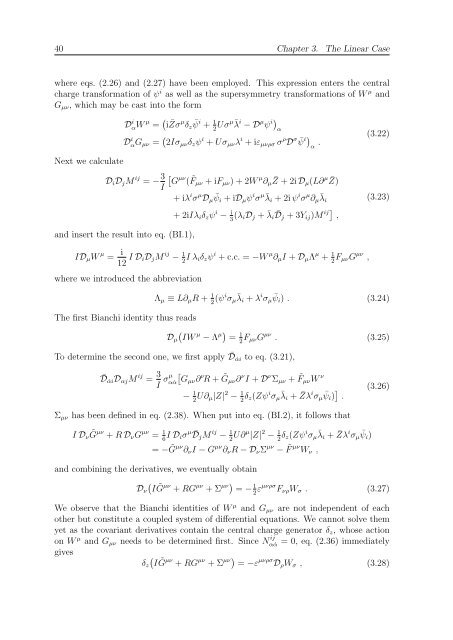N=2 Supersymmetric Gauge Theories with Nonpolynomial Interactions
N=2 Supersymmetric Gauge Theories with Nonpolynomial Interactions
N=2 Supersymmetric Gauge Theories with Nonpolynomial Interactions
You also want an ePaper? Increase the reach of your titles
YUMPU automatically turns print PDFs into web optimized ePapers that Google loves.
40 Chapter 3. The Linear Case<br />
where eqs. (2.26) and (2.27) have been employed. This expression enters the central<br />
charge transformation of ψ i as well as the supersymmetry transformations of W µ and<br />
Gµν, which may be cast into the form<br />
Next we calculate<br />
D i αW µ = i ¯ Zσ µ δz ¯ ψ i + 1<br />
2 Uσµ¯ λ i − D µ ψ i <br />
α<br />
D i αGµν = 2Iσµνδzψ i + Uσµνλ i + iεµνρσ σ ρ D σ ¯ ψ i <br />
α .<br />
DiDjM ij = − 3<br />
I<br />
and insert the result into eq. (BI.1),<br />
G µν ( ˜ Fµν + iFµν) + 2W µ ∂µ ¯ Z + 2i Dµ(L∂ µ ¯ Z)<br />
+ iλ i σ µ Dµ ¯ ψi + iDµψ i σ µ¯ λi + 2i ψ i σ µ ∂µ ¯ λi<br />
+ 2iIλiδzψ i − i<br />
3 (λiDj + ¯ λi ¯ Dj + 3Yij)M ij ,<br />
IDµW µ = i<br />
12 I DiDjM ij − 1<br />
2 I λiδzψ i + c.c. = −W µ ∂µI + DµΛ µ + 1<br />
2 FµνG µν ,<br />
where we introduced the abbreviation<br />
(3.22)<br />
(3.23)<br />
Λµ ≡ L∂µR + 1<br />
2 (ψi σµ ¯ λi + λ i σµ ¯ ψi) . (3.24)<br />
The first Bianchi identity thus reads<br />
µ µ<br />
Dµ IW − Λ = 1<br />
2FµνG µν . (3.25)<br />
To determine the second one, we first apply ¯ D ˙αi to eq. (3.21),<br />
¯D ˙αiDαjM ij = 3<br />
I σµ<br />
<br />
α ˙α Gµν∂ ν R + ˜ Gµν∂ ν I + D ν Σµν + ˜ FµνW ν<br />
− 1<br />
2U∂µ|Z| 2 − 1<br />
2δz(Zψ i σµ ¯ λi + ¯ Zλ i σµ ¯ ψi) .<br />
Σµν has been defined in eq. (2.38). When put into eq. (BI.2), it follows that<br />
I Dν ˜ G µν + R DνG µν = 1<br />
6 I Diσ µ ¯ DjM ij − 1<br />
2 U∂µ |Z| 2 − 1<br />
2 δz(Zψ i σµ ¯ λi + ¯ Zλ i σµ ¯ ψi)<br />
= − ˜ G µν ∂νI − G µν ∂νR − DνΣ µν − ˜ F µν Wν ,<br />
(3.26)<br />
and combining the derivatives, we eventually obtain<br />
<br />
Dν IG ˜µν µν µν<br />
+ RG + Σ = − 1<br />
2εµνρσFνρWσ . (3.27)<br />
We observe that the Bianchi identities of W µ and Gµν are not independent of each<br />
other but constitute a coupled system of differential equations. We cannot solve them<br />
yet as the covariant derivatives contain the central charge generator δz, whose action<br />
on W µ and Gµν needs to be determined first. Since N ij<br />
α ˙α = 0, eq. (2.36) immediately<br />
gives<br />
<br />
δz IG ˜µν µν µν<br />
+ RG + Σ = −ε µνρσ DρWσ , (3.28)

















